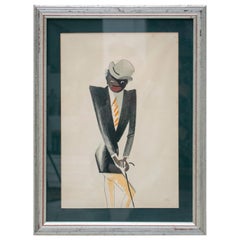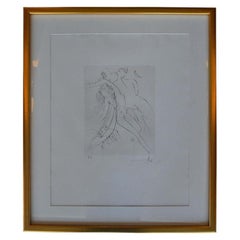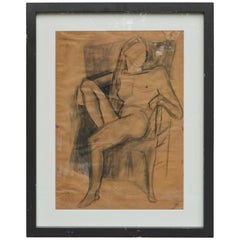Paul Colin Decorative Art
French, 1892-1985
Paul Colin (French , 1892-1985) was a French artist widely recognized for his imaginatively configured art deco posters depicting many well known theatre performers in Paris in the 1920's and 1930's, such as Josephine Baker and modernist figures and nudes. He also specialized in theatre sets, book designs, and costume design. Influenced by Cubism and jazz, he often employed a collage-like methodology to his work, juxtaposing highly stylized figural compositions against geometrically overlapping objects.He was a student of Valin and Prouvre. He created performance posters that were highly stylized, for studio, arts and dance. He was awarded an inspiring graphic artist and had his own unique style as he embraced symbolism and an abstract style.to
1
1
Height
to
Width
to
1
1
1
1
1
1
1
1
1
75
378
247
237
89
Creator: Paul Colin
Black Man Pastel Painting Signed Paul Colin, 1925
By Paul Colin
Located in Marbella, ES
Black man pastel painting signed Paul Colin, 1925.
Dimensions with frame: 59.5 x 44 x 2.5cm.
Category
Early 20th Century French Art Deco Paul Colin Decorative Art
Materials
Paint
Related Items
Salvador Dali Signed Lithograph
By Salvador Dalí
Located in Los Angeles, CA
Salvador Dali Signed Lithograph, 1970s.
Category
1970s Spanish Vintage Paul Colin Decorative Art
Materials
Paper
Sitting Female Nude Sketch Painting, Signed 1974
Located in Haddonfield, NJ
20th Century Female Nude Sketch Painting In Black Frame, Signed 1974
Beautiful nude sketch of the female form signed and dated by the artist, 11...
Category
20th Century American Mid-Century Modern Paul Colin Decorative Art
Materials
Paper
Art Deco Black Panther by Paul Jouve
By Paul Jouve
Located in Miami, FL
Art Deco etching of walking black panther by french artist Paul Jouve signed on the lower left side.
Category
Early 20th Century French Art Deco Paul Colin Decorative Art
Materials
Paper
Charcoal Drawing on Ingrès Paper Signed Marceau Constantin Original, F113
By Marceau Constantin
Located in Ternay, Auvergne-Rhône-Alpes
Charcoal drawing by the French artist Marceau Constantin (1918 - 2017). Drawing on ingres paper representing two characters in shades of black and grey creating a fascinating light a...
Category
1960s French Mid-Century Modern Vintage Paul Colin Decorative Art
Materials
Paper
$1,311
H 27.56 in W 19.69 in D 0.79 in
John F. Kennedy Portrait, Original Drawing Pencil on Paper Dated 1963, Signed
Located in Frankfurt am Main, DE
John F. Kennedy Portrait - original drawing in pencil and charcoal on paper, realized by Detlef Henze, hand-signed, dated December 25, 1963.
Provenance. Private collection
Charcoal...
Category
Mid-20th Century German Paul Colin Decorative Art
Materials
Paper
$876
H 15.4 in W 11.5 in D 0.5 in
John F. Kennedy Portrait, Original Drawing Pencil on Paper Dated 1963, Signed
Located in Frankfurt am Main, DE
John F. Kennedy Portrait - original drawing in pencil and charcoal on paper, realized by Detlef Henze, hand-signed, dated December 25, 1963.
Provenance. Private collection
Charcoal...
Category
Mid-20th Century German Paul Colin Decorative Art
Materials
Paper
$700 Sale Price
20% Off
H 15.4 in W 11.5 in D 0.5 in
Unknown Academy Student 19th C Drawing, Pencil on Paper, Framed, Signed
Located in Leuven , BE
Unknown academy student 19th C drawing, pencil on paper, Framed, Signed.
Category
19th Century Belgian Antique Paul Colin Decorative Art
Materials
Paper
$715
H 29.53 in W 22.45 in D 1.97 in
Large Vintage Asian Bali Art Painting signed J.Wikarma'90
Located in Vilnius, LT
Large Balinese art painting in oil on fabric with flowers and birds.
Frame in green lacquered wood.
Signed by the author: J.Wikarma'90.
Very good/excellent vintage condition.
Category
Late 20th Century Balinese Paul Colin Decorative Art
Materials
Paint, Textile
19th C, Drawing on Paper, Dated, Signed and Framed
Located in Leuven , BE
Unknown Academy Student 19th C Drawing, pencil on paper.
Category
19th Century Belgian Antique Paul Colin Decorative Art
Materials
Paper
1967 Etching Titled, Dated, Signed "Nocturnal Abode" #3/7 by Artist H Valoff
Located in Monrovia, CA
Vintage 1967 original etching named signed and numbered "Nocturnal Abode" #3/7 H. Valoff 1967.
1967 Original etching by Artist H. Valoff Is Framed And Ready To Hang.
Nocturnal Ab...
Category
Mid-20th Century American Paul Colin Decorative Art
Materials
Paper
$2,200
H 20 in W 16 in D 1 in
French Art Deco Black and White Framed Drawing
Located in Houston, TX
French Art Deco black and white framed drawing.
Beautifully executed stylized French Art Deco black and white drawing in a giltwood frame wit...
Category
1920s French Art Deco Vintage Paul Colin Decorative Art
Materials
Paper
1962 Etching Titled, Dated, Signed Numbered "Moscow Symposium" #4/4 H. Valoff
Located in Monrovia, CA
Vintage 1962 original Etching titled, dated, signed and numbered "Moscow Symposium" #4/4 H. Valoff 1962.
1962 original etching by Artist H. Valoff is framed and ready to hang.
Mo...
Category
Mid-20th Century Mid-Century Modern Paul Colin Decorative Art
Materials
Other
$2,250
H 18 in W 31.25 in D 0.5 in
Paul Colin decorative art for sale on 1stDibs.
Paul Colin decorative art are available for sale on 1stDibs. These distinctive items are frequently made of paint and are designed with extraordinary care. There are many options to choose from in our collection of Paul Colin decorative art, although black editions of this piece are particularly popular. Many of the original decorative art by Paul Colin were created in the Art Deco style in france during the early 20th century. If you’re looking for additional options, many customers also consider decorative art by and Erté. Prices for Paul Colin decorative art can differ depending upon size, time period and other attributes — on 1stDibs, these items begin at $3,774 and can go as high as $3,774, while a piece like these, on average, fetch $3,774.


